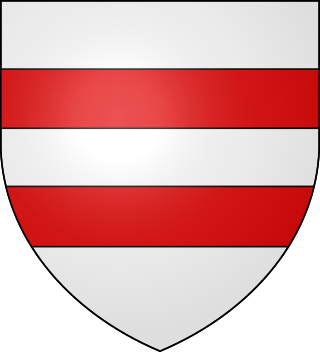
The Middleton Baronetcy, of Hackney in the County of Middlesex, was created in the Baronetage of England on 6 December 1681 for Hugh Middleton. The title became extinct on his death in 1702. [2]

The Middleton Baronetcy, of Hackney in the County of Middlesex, was created in the Baronetage of England on 6 December 1681 for Hugh Middleton. The title became extinct on his death in 1702. [2]

There have been six baronetcies created for persons with the surname Smyth, two in the Baronetage of England, one in the Baronetage of Great Britain, one in the Baronetage of Ireland and two in the Baronetage of the United Kingdom. One creation is extant as of 2010.
There have been three baronetcies created for members of the Assheton family, two in the Baronetage of England and one in the Baronetage of the United Kingdom. Two of the creations are extinct while one is extant.
Nineteen baronetcies have been created for persons with the surname Hamilton, eight in the Baronetage of Nova Scotia, one in the Baronetage of England, five in the Baronetage of Ireland, one in the Baronetage of Great Britain and four in the Baronetage of the United Kingdom. As of 2008 two creations are extant, two are dormant, two are either extinct or dormant and twelve extinct.

There have been three Evelyn Baronetcies, two in the Baronetage of England and one in the Baronetage of Great Britain. These are shown individually below in order of creation. The three families are closely related[Usurped!] and made their money out of gunpowder.
There have been five baronetcies created for people with the surname Napier, three in the Baronetage of England, one in the Baronetage of Nova Scotia and one in the Baronetage of the United Kingdom. As of 2014 two of the creations are extant.

The Alleyn Baronetcy, of Hatfield in the County of Essex, was a title in the Baronetage of England. It was created on 24 June 1629 for Edward Alleyn. The title became extinct on the death of the eighth Baronet in 1759.

There have been two baronetcies created for persons with the surname Backhouse, once in the Baronetage of England and once in the Baronetage of the United Kingdom. As of 2023 one creation is extant.
Sir John Houstoun of that Ilk, 2nd Baronet was a member of the Parliament of Scotland for Renfrewshire from 1685 to 1686 and 1702 to 1707 and for Stirlingshire in 1689 then from 1689 to 1702.

There have been twenty one baronetcies created for persons with the surname Williams, eight in the Baronetage of England, three in the Baronetage of Great Britain and ten in the Baronetage of the United Kingdom. Only six of the creations are extant as of 2017.

There have been four baronetcies created for persons with the surname Hope, three in the Baronetage of Nova Scotia and one in the Baronetage of the United Kingdom. As of 2010 one creation is extant, one dormant and two extinct.
There have been seven baronetcies created for persons with the surname Edwards, three in the Baronetage of England and four in the Baronetage of the United Kingdom. Only one creation is extant as of 2007.
There have been four baronetcies created for persons with the surname Rich, two in the Baronetage of England, one in the Baronetage of Great Britain and one in the Baronetage of the United Kingdom. As of 2008 three of the creations are extinct while one is dormant.

There have been two baronetcies created for persons with the surname Goring, both in the Baronetage of England. The second creation came into the family through a special remainder in the patent creating the baronetcy. Only the latter creation is extant as of 2008.

There have been six baronetcies created for members of the Corbet family, four in the Baronetage of England, one in the Baronetage of Great Britain and one in the Baronetage of the United Kingdom. All creations are extinct. The recipients were descendants of the ancient Norman family of Corbet which held substantial estates in Shropshire including Wattlesborough, Caus Castle, Moreton Corbet Castle and Acton Reynald Hall.
Sir Hugh Cholmeley, 4th Baronet was an English politician and baronet.
The Hoby Baronetcy, of Bisham in the County of Berkshire, was a title in the Baronetage of England. It was created on 12 July 1666 for Edward Hoby, the son of Peregrine Hoby (1602–1679), during his father's lifetime.

The Lovett Baronetcy, of Liscombe House in the County of Buckingham, was a title in the Baronetage of Great Britain. It was created on 23 October 1781 for Jonathan Lovett of Liscombe in the parish of Soulbury, Buckinghamshire. He was subsequently offered a peerage but declined, on the grounds that his only son had died. Lovett married Sarah Darby, but died in 1812 without surviving male issue, his son Robert Turville Jonathan Lovett having pre-deceseased him in 1807, and thus the title became extinct.

The Assheton Baronetcy, of Middleton in the County of Lancaster, was created in the Baronetage of England on 17 August 1660 for Ralph Assheton. The second Baronet sat as Member of Parliament for Liverpool and Lancashire. The title became extinct on the death of the third Baronet in 1765.

The Mainwaring baronetcy of Over-Peover, Cheshire, was created on 22 November 1660 by Charles II on his restoration, for Thomas Mainwaring, High Sheriff of Cheshire in 1657 and Knight of the Shire otherwise Member of Parliament for Cheshire in 1660. The baronetcy was extinct on the death of the 4th Baronet.